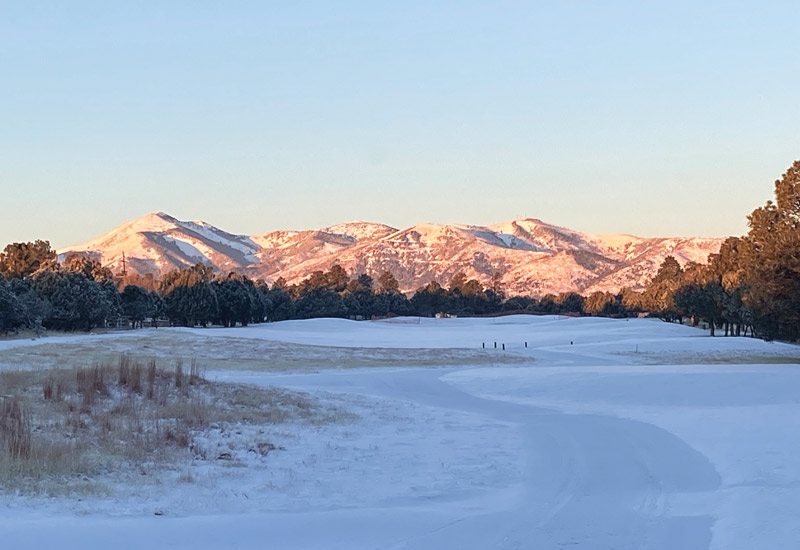
Despite occasional snowfall, Alto Lakes Golf and Country Club (and its views of Sierra Blanca) remains open in the winter. Photo by Glenn Denney
For golf course superintendents in the Southwest, winter maintenance practices depend on elevation, weather and even wildlife. In New Mexico, for example, one course may have Tucson-like weather while a nearby course seems more like Denver.
Southern New Mexico’s Desert Lakes Golf Course in Alamogordo, elevation 4,300 feet, might enjoy 60-degree, sunny conditions while the fourth-highest golf course in the country — The Lodge Golf Course at Cloudcroft, elevation 9,000 feet and just 20 miles away — sits under a 16-inch February snowfall. Between these extremes are rolling hills and mesas, neither desert nor mountain.
So how do winter maintenance practices compare from desert to mesa to mountain?
For Mac Blevins, a 19-year GCSAA member and superintendent at Desert Lakes, play is usually delayed only by waiting for frost to melt. Occasional snowfall disappears in a day, giving way to blue skies, so snow mold isn’t a problem. Blevins sees little pressure from weeds or wildlife.
Like many superintendents, Blevins faced labor challenges during the pandemic but has had good luck hiring recently, so winter work has focused on addressing delayed maintenance tasks.
About 55 miles north, Alto Lakes Golf and Country Club faces different obstacles.
“We stay open throughout the winter months,” says superintendent Glenn Denney, CGCS, a 25-year association member. “We are one of the few above 7,000 feet that do. So, when the course is playable or semi-playable — clear of snow — we allow play.”
Some years at scenic Alto Lakes, which sits in foothills near Sierra Blanca, a 12,003-foot peak, snowfall is plentiful. Other years, the peak is the only place covered in white.
The biggest concern going into the winter is desiccation, Denney says. “A normal winter has enough rain and snow to provide adequate moisture to get through December-March. However, during drought times, we do have to irrigate, causing problems with our irrigation system.”
Editor’s note: Is it crown hydration or anoxia? Would a permeable or impermeable cover be best? Match injury to defense and get more know-how on seeing turf through winter in Winter turf damage and turf covers: A guide.
Winter prep includes fencing off greens to deter grazing animals; irrigation up to freezing temperatures during the day; snow mold prevention and protection; and covering greens that are shaded. Time had been devoted to shop projects, tree-trimming and other tasks, but over the past seven to 10 years, “We have become a feeding ground for deer, elk and wild horses,” which graze constantly and leave hundreds of pounds of droppings nightly. The crew must operate sweepers nearly every day rather than work on other tasks.
About 200 miles north, Black Mesa Golf Club experiences similar weather, though at a lower elevation — 5,700 feet — in northern New Mexico’s Española Valley.
“We are cool-season grass wall-to-wall,” says superintendent Aaron Sunderlin, a 16-year GCSAA Class A member. “Our greens are bentgrass and everything else is a ryegrass/bluegrass mixture.”
The Black Mesa crew prepares for winter starting around late November with a cart-path-only restriction. Before greens freeze, three cups are cut in every green so pin positions can be rotated throughout winter. Regular mowing ends as turf enters dormancy, although greens are mowed occasionally to remove debris.
“This year we watered into the third week of December due to no moisture during the fall,” Sunderlin says. While the irrigation system is still charged, wetting agents are applied to achieve an even soil moisture.
“Wetting agents will also assist in rewetting the soil during the cold winter months when we do receive moisture from Mother Nature,” he says. The system is blown out in late December to prepare for cold nights in January and February. “We can charge our mainline only and utilize frost-free hydrants located at every green during the winter to hand-water greens if needed.”
No fertilization is done December through March.
“In early November when final fairway and rough mowing has been completed, I apply ammonium sulfate to fairway and high-traffic-rough areas,” Sunderlin says. “Greens receive a slow-release granular application in late October and a liquid application of ammonium sulfate in early November.” These late-season applications help retain turf color well into the winter with quick green up and good color during spring months.
At nearby Towa Golf Resort in the Pojoaque Valley (elevation 6,200 feet), near Santa Fe, GCSAA Class A superintendent Jimmy Rodriguez, director of golf course maintenance and a 24-year association member, also keeps carts on paths, slows mowing, aerates if time allows and puts down a slow-release granular fertilizer and a granular calcium (lime and gypsum) soil amendment. Both applications pay big dividends in spring, he says.
“We apply several fungicides during the last week of November before we blow out the irrigation system,” Rodriguez says. The second application is timed when snowfall is expected. “The first and second apps of fungicide, I add a gallon of pigment to ensure a slight green color to help keep the greens a bit warmer. This has greatly helped in the spring to green back up. I now also do the same on the tees and the fairways.”
Despite the challenges, whether wildlife, weather, water or otherwise, the superintendents agree the bottom line is providing the best experience possible for golfers.
“I recognize that there is a really strong base here of golfers,” Blevins says. “They just want to be taken care of.”
Darrell J. Pehr is GCM’s science editor.